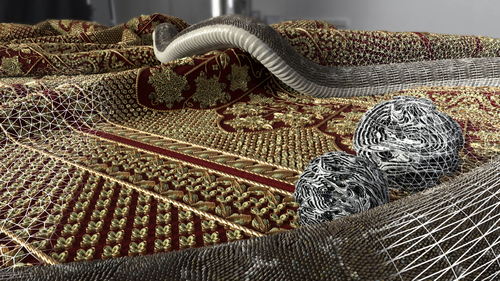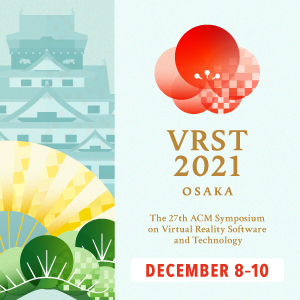19. Real-time Rendering [Q&A Session]
-
 Full Access
Full Access
-
 Onsite Student Access
Onsite Student Access
-
 Virtual Full Access
Virtual Full Access
Date/Time: 06 – 17 December 2021
All presentations are available in the virtual platform on-demand.
ExtraNet: Real-time Extrapolated Rendering for Low-latency Temporal Supersampling
Abstract: Both the frame rate and the latency are crucial to the performance of real-time rendering applications such as video games. Spatial supersampling methods, such as the Deep Learning SuperSampling (DLSS), have been proven successful at decreasing the rendering time of each frame by rendering at a lower resolution. But temporal supersampling methods that directly aim at producing more frames on the fly are still not practically available. This is mainly due to both its own computational cost and the latency introduced by interpolating frames from the future. In this paper, we present ExtraNet, an efficient neural network that predicts accurate shading results on an extrapolated frame, to minimize both the performance overhead and the latency. With the help of the rendered auxiliary geometry buffers of the extrapolated frame, and the temporally reliable motion vectors, we train our ExtraNet to perform two tasks simultaneously: irradiance in-painting for regions that cannot find historical correspondences, and accurate ghosting-free shading prediction for regions where temporal information is available. We present a robust hole-marking strategy to automate the classification of these tasks, as well as the data generation from a series of high-quality production-ready scenes. Finally, we use lightweight gated convolutions to enable fast inference. As a result, our ExtraNet is able to produce plausibly extrapolated frames without easily noticeable artifacts, delivering a 1.5x to near 2x increase in frame rates with minimized latency in practice.
Author(s)/Presenter(s):
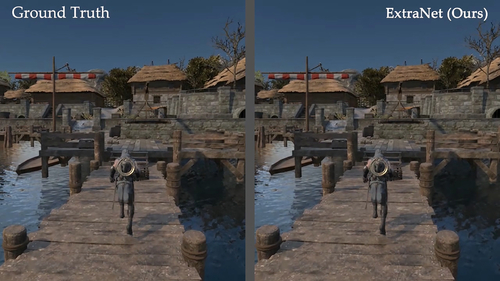
Fast Volume Rendering with Spatiotemporal Reservoir Resampling
Abstract: Volume rendering under complex, dynamic lighting is challenging, especially if targeting real-time. To address this challenge, we extend a recent direct illumination sampling technique, spatiotemporal reservoir resampling, to multi-dimensional path space for volumetric media. By fully evaluating just a single path sample per pixel, our volumetric path tracer shows unprecedented convergence. To achieve this, we properly estimate the chosen sample’s probability via approximate perfect importance sampling with spatiotemporal resampling. A key observation is recognizing that applying cheaper, biased techniques to approximate scattering along candidate paths (during resampling) does not add bias when shading. This allows us to combine transmittance evaluation techniques: cheap approximations where evaluations must occur many times for reuse, and unbiased methods for final, per-pixel evaluation. With this reformulation, we achieve low-noise, interactive volumetric path tracing with arbitrary dynamic lighting, including volumetric emission, and maintain interactive performance even on high-resolution volumes. When paired with denoising, our low-noise sampling helps preserve smaller scale volumetric details.
Author(s)/Presenter(s):
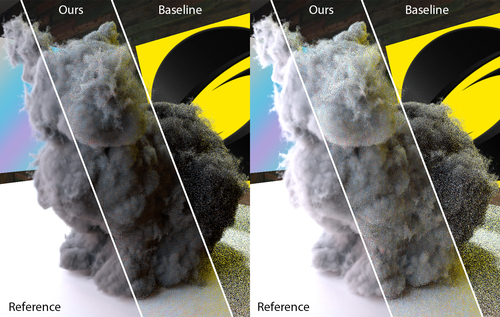
Fast and Accurate Spherical Harmonics Products
Abstract: Spherical Harmonics (SH) have been proven as a powerful tool for rendering, especially in real-time applications within the Precomputed Radiance Transfer (PRT) system. Spherical harmonics possess nice properties such as the orthogonality. However, computations of triple products and multiple products operations are often the bottlenecks that prevent moderately high-frequency use of spherical harmonics. Specifically, the previous method for accurate SH triple products of order $n$ has a time complexity of $O(n^5)$, which is a heavy burden for most real-time applications. Even worse, a brute-force way to compute $k$-multiple products would take $O(n^{2k})$ time. In this paper, we propose a fast and accurate method for spherical harmonics triple products with the time complexity of only $O(n^3)$, and easily extensible to $k$-multiple products with the time complexity of $O(kn^3+k^2n^2\log(kn))$. Our key insight is to conduct the triple and multiple products in the Fourier space, in which the multiplications can be performed much more efficiently. To our knowledge, our method is theoretically the fastest for accurate spherical harmonics triple and multiple products. And in practice, we demonstrate the efficiency of our method in mid-frequency relighting and occlusion shadow fields applications.
Author(s)/Presenter(s):
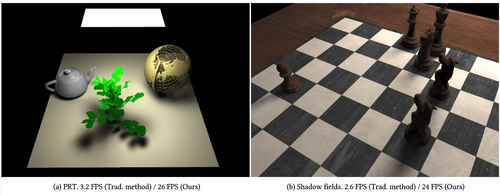
Perceptual Model for Adaptive Local Shading and Refresh Rate
Abstract: When the rendering budget is limited by power or time, it is necessary to find the combination of rendering parameters, such as resolution and refresh rate, that could deliver the best quality. Variable-rate shading (VRS), introduced in the last generations of GPUs, enables fine control of the rendering quality, in which each 16x16 image tile can be rendered with a different ratio of shader executions. We take advantage of this capability and propose a new method for adaptive control of local shading and refresh rate. The method analyzes texture content, on-screen velocities, luminance, and effective resolution and suggests the refresh rate and a VRS state map that maximizes the quality of animated content under a limited budget. The method is based on the new content-adaptive metric of judder, aliasing, and blur, which is derived from the psychophysical models of contrast sensitivity. To calibrate and validate the metric, we gather data from literature and also collect new measurements of motion quality under variable shading rates, different velocities of motion, texture content, and display capabilities, such as refresh rate, persistence, and angular resolution. The proposed metric and adaptive shading method is implemented as a game engine plugin. Our experimental validation shows a substantial increase in preference of our method over rendering with a fixed resolution and refresh rate, and an existing motion-adaptive technique.
Author(s)/Presenter(s):
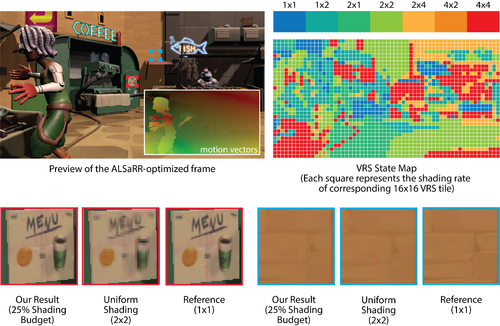
Tessellation-Free Displacement Mapping for Ray Tracing
Abstract: Displacement mapping is a powerful tool for adding fine to medium geometric details over an existing surface. While GPU rasterization supports it through the hardware tessellation unit, ray tracing surface meshes textured with high quality displacement requires a significant amount of memory. More precisely, the input surface needs to be pre-tessellated at the displacement map resolution before being enriched with its mandatory acceleration data structure. Consequently, designing displacement maps interactively while enjoying a full physically-based rendering is often impossible, as simply tiling multiple times the map quickly saturates the graphics memory. In this work, we introduce a new tessellation-free displacement mapping approach for ray tracing. Our key insight is to decouple the displacement from its base domain by mapping a displacement-specific acceleration structures directly on the mesh. As a result, our method shows low memory footprint and fast high resolution displacement rendering, making possible to edit the displacement content interactively.
Author(s)/Presenter(s):
